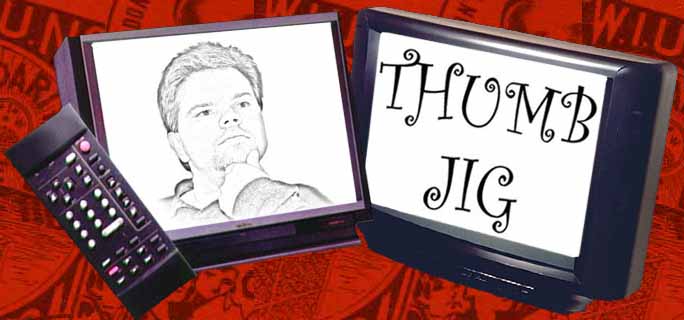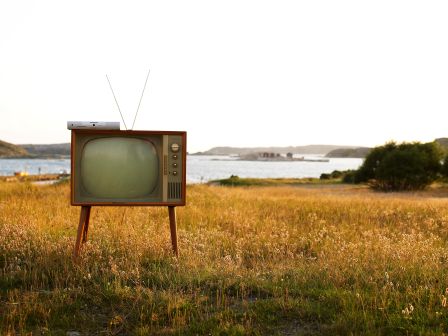Grand Theft Digital: How Corporate Broadcasters Will Hijack Digital TV
On February 17, 2009 a massive, but so far little-noted corporate theft of the public airwaves will be consummated as US analog TV stations switch to digital TV (DTV) broadcasting. Digital broadcast technology enables three, four and sometimes more separate channels to be compressed into the space formerly occupied by a single old-fashioned analog TV channel. So when the transition from analog to digital TV occurs nationwide on February 17, 2009 each of the nation’s more than 1700 broadcast TV license holders will suddenly have two, three or more additional channels, a gift from the taxpayers worth an estimated $70 billion.
Back in the mid 1990s, the owners of TV stations promised Congress that the advent of DTV would bring with it wide selection of new programming, educational and children’s shows, frequently updated local newscasts and interactive content, all free over the new digital broadcast airwaves. Of course, they lied.
“Broadcasters have no idea how they will fill the extra channels they’ll get on February 18, 2009,” Communications Workers of America’s Carrie Biggs-Adams told BAR. They don’t have the content and they don’t have a clue. There are only so many reruns, reality shows and home shopping networks.”
An article by David Hatch in the June 7 National Journal confirms this
With the February 17 shift to digital broadcasting just over eight months away, broadcasters are finding that the business model for multiple channels is not panning out. An often-repeated refrain is that there’s no money in it. “You’re not creating any new advertisers, and you’re not creating any new viewers,” said Shaun Sheehan, vice president of the Tribune Co., which carried an all-music channel called The Tube on some of its secondary digital stations before the network folded in October.
“It’s just a pure business decision,” said James McQuivey, a media analyst with Boston-based Forrester Research. “Do I run the risk of rolling out new channels that will dilute my audience base?”
The National Association of Broadcasters cited statistics from BIA Financial, a Chantilly, Va.-based research firm, indicating that 351 television stations are multicasting.
But that figure includes public broadcasters, which have invested heavily in extra stations and account for a large chunk of the ones available–compared with their commercial counterparts.
When commercial outlets do multicast, it is often to transmit redundant weather maps, which involves minimal investment and little or no on-air talent. These radar scopes are so widespread that they’ve saturated the airwaves in some markets, including Washington, where viewers have three to choose from. Commercial broadcasters “can say that they do have some content on there,” the FCC source said derisively.
Although the airwaves are the property of the public under US law, and broadcasters receive their licenses from the FCC only on the condition that they serve the public interest, neither Congress nor the FCC, have attached any public service or public interest requirement to the thousands of new DTV channels that current broadcasters will receive. And current broadcasters, according to the deal worked out by Congress and the FCC back in the 1990s, are the only ones upon whom the new stations made possible by DTV will be bestowed. They’re in. Congress and the FCC, in their wisdom didn’t think local governments, schools, colleges, libraries, unions, community organizations, local churches, blacks, Latinos or females deserved a shot at any of the thousands of new DTV channels. They’re out. That’s it and that’s all.
The DTV transition has been engineered at every level to shield broadcasters from public scrutiny or accountability. You’d think four times as many TV stations would mean the FCC would have to issue four times as many broadcast licenses. But the issuance of new licenses would make public debate about who gets them and under what conditions unavoidable. So the new stations will be brought online under existing licenses.
The simple fact that DTV means the number of available channels will increase three or four times without a single broadcast license being issued to any new players is being carefully and deliberately concealed from the American people, lest there be a public debate on whether broadcasters actually deserve the new channels, and to what other use the newly available public spectrum might be put. For example, to find a reference to and definition of “digital multicasting”, the technical name for the ability to place multiple channels in the bandwidth formerly occupied by a single analog channel, you have to hit the “What is DTV” page on the FCC web site, then click the link on the word “multicasting” and read the pop-up to learn that DTV
“allow(s) each digital broadcast station to split its bit stream into 2, 3, 4 or more individual channels of programming and/or data services. (For example, on channel 7, you could watch 7-1, 7-2, 7-3 or 7-4.)”
BAR had to spend 30 minutes on the phone, calling a half dozen FCC numbers and speaking to nine staffers just to find that reference. There are others, but few are easily discovered.
What’s easy to find in the press and on the FCC’s DTV site are the empty promises of broadcasters that DTV will mean more programming choices for the public, along with hundreds of thousands of words about whether old and new TV sets will be able to receive the new DTV signals and how well, who needs set-top converter boxes and who doesn’t and who pays for them and how.
The broadcast industry is a closed club which reaps vast private profits from its monopoly use of a limited public resource, namely the public airwaves. No clever entrepreneur or smart engineer invented the broadcast spectrum that carries radio, TV and other wireless communications. The spectrum is a fundamental property of the physical universe. The FCC is charged with regulating the use of the spectrum in the public interest.
But the FCC is effectively the captive and sock puppet for the broadcasters club. The FCC has managed to spend millions on informing the public about the impending transition to DTV, with a staff of hundreds, public meetings, extensive web sites, dozens of videos, and complete “outreach toolkits” full of sample press releases for government and community organizations to conduct DTV transition awareness programs. The FCC’s desired level of public “awareness” is limited to how to acquire a converter box or a DTV-capable set and turn it on. This treatment of the American people as “consumers” — as commodities to be manipulated rather than empowered citizens, the actual owners of the broadcast spectrum is conclusive evidence that the FCC is wholly captured by and run in the interest of the broadcast industry.
Although the FCC’s digital TV web site and handouts repeat the empty promises of broadcasters for more variety, for educational and public service programming on DTV they do it without mentioning that there will be three or four times as many channels, let alone entertaining the question whose channels those will be. The questions of who owns the limited resource of broadcast airwaves, who is entitled to broadcast licenses and under what conditions, and in whose interest the public spectrum must be managed are entirely absent from the FCC’s public “awareness” programs. The fix is definitely in.
On February 18, 2009, 1700 existing TV broadcasters get multiple new channels with no public service obligation. The rest of us get nothing, unless you count set-top converter boxes and more channels to watch infomercials, “reality” shows, the jewelry channel and the home shopping network in beautiful high-def TV. Although broadcast TV is a local medium with most station footprints only a few dozen miles in radius, the transition will occur simultaneously nationwide. This will make local organizing aimed at opening up distribution of new licenses for the new channels or forcing some degree of broadcaster accountability extraordinarily difficult. But there is one bright spot.
The FCC, in its wisdom, has designated an early test rollout of the new broadcast regime to take effect in a single city; Wilmington NC, on September 8, 2008. Wilmington is an historic port city with a population of about 100,000, a quarter of whom are black.
If there is truly a nationwide movement for media justice it must rear its head in the next few weeks. The people of Wilmington NC know they deserve more choices, more localism, more news and more control over their media than they have now. Right now, they don’t know know that Wilmington’s four local TV stations are about to become sixteen stations with no increase in local accountability, no new local news or public service, no local arts, and certainly no local ownership. They must be told.
If there is a nationwide media justice “movement” worthy of that name it will concentrate its resources in a public education campaign and a mass mobilization, first in Wilmington NC and then nationwide with the aim of overthrowing the cozy deal broadcasters have worked out with their puppets in the FCC and the Congress. There will be another new Congress soon, and another president. This is a political moment when much is possible, but only in the context of a broad and sustained demand to overthrow the secretive sweetheart deal broadcasters have cooked up for themselves to monopolize the newly available digital TV channels. That’s what real movements do — they seize key political moments, they conduct mass education campaigns to take us someplace we would never go without them.
The FCC, the current Congress and candidates for the next one, presidential candidates and everybody else should be forced to explain repeatedly over the next few months why thousands of newly available digital TV channels should not go to thousands of new local broadcasters — to community organizations, local entrepreneurs, local churches, schools and unions, to blacks, Latinos, Native Americans and to women. It’s our spectrum. It’s our public space. It’s our right.
If a nationwide movement for media justice really exists, it must begin to expose the privatization of the public airwaves hidden in plain sight under the guise of the “transition” from analog to digital TV. It must harness the power of the people to challenge this grand theft of our digital destiny.
Bruce Dixon is BAR Managing Editor.
© Black Agenda Report
Friday, June 13, 2008
Grand Theft Digital: How Corporate Broadcasters Will Hijack Digital TV
Labels:
Corporate Control of the Media,
DTV,
FCC
Subscribe to:
Post Comments (Atom)



No comments:
Post a Comment